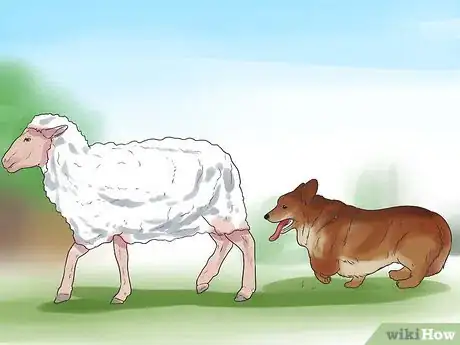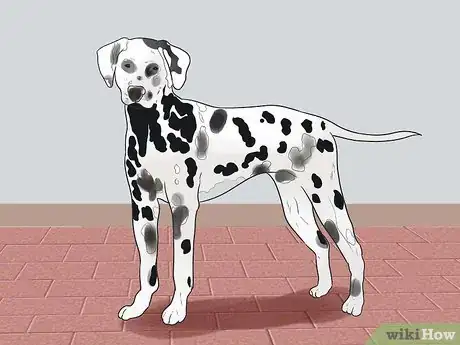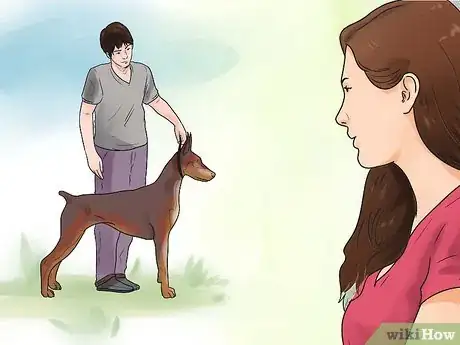This article was co-authored by John Jess. John Jess is a Dog Breeder and the Founder of Central Illinois Doodles, a family business located in Arthur, Illinois. He specializes in breeding Goldendoodles and Bernedoodles. Central Illinois Doodles has been named one of the Top 10 Bernedoodle breeders in the United States by Bubbly Pet and Pupvine. They’ve also been named one of the best Goldendoodle breeders by Trending Breeds and Devoted to Dog.
This article has been viewed 38,286 times.
If you love dogs, but do not know the breeds, it can be hard to determine if a little white dog is a Maltese, a Bichon Frise, or a poodle. Large dog breeds can be just as confusing. Luckily, with a little practice you can learn the various breeds of dog in a general sense, which will help you learn your hounds from your hunters. Kennel club associations have dogs grouped according to type, size, purpose, and similar traits. By studying these broad categories you can learn to place dogs into their appropriate groups and then into the various breeds within each group.
Steps
Learning Dog Groups
-
1Understand how dogs are grouped together. There are more than 150 dog breeds recognized by the American Kennel Club (AKC). These breeds are organized into seven groups based upon characteristics and function of the dogs.
- Remember that these 150 breeds are only the tip of the iceberg. There are over 400 breeds worldwide.[1]
-
2Familiarize yourself with the toy breeds. The toy breeds are the smallest breeds of dogs. They can be long haired or short haired, with floppy ears or erect ears, and all fur colors imaginable. Their primary purpose (function) is to be companions to their human owners. They are ideal pets for dog lovers that live in small homes or apartments in cities.
- These dogs are usually weigh 10 pounds or less. Due to their smaller size, they generally cost less to own than larger breeds of dogs and can be physically easier to control.
- Popular toy breeds include Chihuahuas, Toy Poodles, Pekingese, Papillons, Pugs, and Yorkshire Terriers.
Advertisement -
3Study the terrier breeds. Terriers can also come in all colors and hair coat lengths, although generally their coats are wiry.[2] They were originally bred to hunt rodents and other vermin. They are generally smaller dogs, which were ideal for fitting into tight spots and rodent burrows. However, some of the dogs are a bit bigger and could tackle larger varmints, such as badgers.
- Popular terrier breeds include the Jack Russell terrier, American Pit Bull Terrier, West Highland Terrier, Cairn terrier, and Fox Terrier.
- Terriers have the reputation as being tough and tenacious (aka stubborn) and generally aren’t the best dog for a first time dog owner due to this trait. They need a firm, yet kind, hand in instilling discipline and training otherwise they will try to run the household.
-
4Familiarize yourself with the hound breeds. The hound breeds were developed to assist their humans in hunting. They differ from other hunting dogs in that they hunt more independently of their humans tracking their prey by sight or scent. There are various sizes and shapes of hounds but the main characteristic is their hunting ability. This is a varied group of dog ranging from the enormous Irish wolfhound to the diminutive dachshund.
- The bloodhound is an example of a hound that tracks by scent. Beagles, bassets, and foxhounds are also breeds of scent hounds. Sight hounds are generally lean and fast, tracking prey with their eyes. Salukis, greyhounds, and whippets are good examples of sight hounds.
-
5Learn about the herding breeds. The herding breeds have been bred to help farmers and shepherds round up and protect livestock. These hard working dogs work in all sorts of weather and over rough terrain. They generally are high energy breed who need plenty of exercise and a job to do; otherwise they can become bored and destructive.
- These dogs are driven to herd, to the point that they will herd children and adults if they have no livestock to control! That being said they will need to be trained not to herd people and given another outlet for their drive and instinct. They make good candidates to be trained for agility or other athletic canine sports.
- Popular herding dogs include the Australian Cattle Dog (Blue Heeler), Border Collie, Belgian Malinois, Collie, and Corgi.
-
6Study the sporting breeds. The sporting breeds of dog are the hunting dogs that hunt under the direction of their owners, generally hunting game with a gun. These are divided into the spaniels, the retrievers, and the pointers and setters. Some dogs retrieve game from land or water, other breeds flush game from tall grasses or brush, while others find the game and “point” with nose where the game is hiding.
- The Labrador retriever is the epitome of this group. Additionally, it consistently ranks at the top of the short list for the most popular breed of dog in the USA. Not without reason, as generally this dog makes a great family pet in addition to a fine hunting companion.
- Other group examples include the Springer spaniel, Golden retriever, English setter, and German Shorthair pointer.
-
7Familiarize yourself with the working breeds. The working breeds of dogs have been bred to protect and guard humans and their property. They also serve as military and police dogs or as service dogs to disabled or blind persons. In addition, some of these sturdy dogs pull sleds. Because of the nature of their “jobs” the working dog is a large to giant dog ready and able to perform their duties in all kinds of condition.
- The Great Pyrenees, a great livestock protector and huge white dog, is one breed in the working group. Alaskan malamutes, Great Danes, Rottweilers, St. Bernards and Doberman Pinschers are other popular breeds in the working group.
-
8Learn about non-sporting breeds. The non-sporting breed is a catch-all group for the breeds that don’t fall into the other six categories. This is a varied group with no one specific task, function or characteristic. They also come in all kinds of sizes, hair coat length and color.
- The Dalmatian, or firehouse dog, is in this group. Its white with black spots coat helps it be easily recognized. The Lhasa Apso—a long haired, small dog—is a popular little companion. The Bulldog, with its thick jowls, stocky build, and tough guy persona is also in the non-sporting group. As you can tell from these three examples, this group has a huge variety of dogs in it.
- Other popular dogs in this group include the Bichon Frise, American Eskimo, the French bulldog, the Boston terrier, the Chow Chow, and the Poodle.
- Some may question why a dog like the Boston terrier isn't in the terrier group. This is because the breed was not originally bred to hunt rodents, but instead was bred relatively recently from existing breeds.
Studying Dog Breeds
-
1Get familiar with the breeds that are common in your area. For instance, if you are in the United States you can study the AKC or Kennel Club recognized breeds first. These are relatively common breeds and are easy to identify.
- Study the dogs each for a group at a time. Go through each "breed type" in each group, this will make it easier to remember in your head.
- First, for example, start with the sporting group. Get familiar with each breed type in the group, the retrievers, then the pointers, then the spaniels, then the setters.
-
2Find information about breeds from a variety of sources. Begin by checking out books on dog breeds from the library. You want to make sure that the author is an expert in the field. You should also be sure that the information contained inside will help you learn breeds names and identifying characteristics of dogs.
- Also look for online sources. Just as with books, make sure the sources are coming from experts in the field. There are many organizations dedicated to specific breeds, so if you want specific information on a breed, an organization dedicated to them may have good information online.
-
3Pick a specific breed to focus on. If you see a dog that you are particularly interested in, focus your attention on it. Learn all about the history of the breed and its characteristics. While some people like to know a little bit about a lot of breeds, some other people are better at specializing their knowledge.
-
4Expand your studying to breeds beyond your local area. For example, after you get familiar with the recognized breeds, get into the Foundation Stock breeds. Foundation Stock breeds are rare breeds that the American Kennel Club keeps record of, but does not register.[3]
- There are over 600 breeds of dogs in the world, so get familiar with the ones in your area first.
-
5Study the description, standard, and history of each breed. This will make it easier for you to remember the breed. You can also learn the different breed colorings, coat types, and sizes. You can find the standards for the AKC recognized breeds at www.akc.org.
- This will help you get familiar with the breeds, and find certain characteristics that will trigger your memory when you see a dog.
- With diligent studying you soon will be able to tell your Keeshond from your coon hounds and become a mini-expert in dog breed recognition. For example, the AKC states that Yorkies should only be blue and tan, but, there are actually some piebald (black and white) Yorkies.
-
6Go to dog parks and try to name each breed. This will help you familiarize yourself with common, popular breeds. If you need help identifying the breed, do key word internet searches to figure out what kind of dog it is. You can also ask the owner. Most owners love talking about their breed!
-
7Go to a local dog show. Local dog and 4-H clubs hold pet shows every year in which they feature many breeds of dogs. State and regional dog shows, some specific for hunting dogs or working dogs, take place around the calendar year. Watch the breed rings, group rings, and if you can, best in show.
- Look at the dogs in the breed rings, watch how they act, what they look like, and how they move. If you see the dogs in person, you will remember them faster.
- Next, go to the group rings. See if you can identify each breed from memory.
-
8Go to a national dog show if you want to see the prime examples of each breed. The crème de la crème in the U.S. is the Westminster Kennel Club dog show which takes place in New York City every February. More than 170 dog breeds compete in this show, which is broken down into the dog groups.
- Each group competes against itself to choose the top dog; the top dog in each in group then competes in one final showing to choose the overall top dog.[5]
- The show is also shown on TV every year. Dog breeds are discussed during the televised events, giving viewers a good overall education in dog breeds.
Expert Q&A
-
QuestionWhat dog breeds are the easiest to train?
 Pippa Elliott, MRCVSDr. Elliott, BVMS, MRCVS is a veterinarian with over 30 years of experience in veterinary surgery and companion animal practice. She graduated from the University of Glasgow in 1987 with a degree in veterinary medicine and surgery. She has worked at the same animal clinic in her hometown for over 20 years.
Pippa Elliott, MRCVSDr. Elliott, BVMS, MRCVS is a veterinarian with over 30 years of experience in veterinary surgery and companion animal practice. She graduated from the University of Glasgow in 1987 with a degree in veterinary medicine and surgery. She has worked at the same animal clinic in her hometown for over 20 years.
Veterinarian The purebred poodle is often overlooked as a highly trainable dog. Another small breed that's good to train is the miniature schnauzer. Moving towards bigger dogs, Labrador retrievers and golden retrievers are eager to please, which makes them good training material.
The purebred poodle is often overlooked as a highly trainable dog. Another small breed that's good to train is the miniature schnauzer. Moving towards bigger dogs, Labrador retrievers and golden retrievers are eager to please, which makes them good training material. -
QuestionWhat breed of dog is the easiest to house train?
 Pippa Elliott, MRCVSDr. Elliott, BVMS, MRCVS is a veterinarian with over 30 years of experience in veterinary surgery and companion animal practice. She graduated from the University of Glasgow in 1987 with a degree in veterinary medicine and surgery. She has worked at the same animal clinic in her hometown for over 20 years.
Pippa Elliott, MRCVSDr. Elliott, BVMS, MRCVS is a veterinarian with over 30 years of experience in veterinary surgery and companion animal practice. She graduated from the University of Glasgow in 1987 with a degree in veterinary medicine and surgery. She has worked at the same animal clinic in her hometown for over 20 years.
Veterinarian Poodles and bichon frise are intelligent little dogs that are eager to please. These are excellent qualities which make them easy to house train.
Poodles and bichon frise are intelligent little dogs that are eager to please. These are excellent qualities which make them easy to house train.
References
About This Article
To learn breeds of dogs, you can start by getting a book from the library or searching online for different breeds. Try to find out about each breed's coat type, size, and history to help you remember it. If you want to see different dog breeds in person, you can go to a dog park and see which ones you already know. If you see a breed you’re unfamiliar with, you can ask its owner, since most people love talking about their dogs. You can also go to a local dog show to see the best looking dogs of lots of breeds. For more tips from our Veterinarian co-author, including how to learn about the seven dog groups, read on!











































































